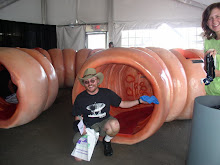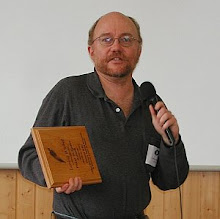Remember that 'free-form radio' has almost always been an oxymoron. - 1969-70
Thanks to some stock-theatre bit parts and backstage set design work, I
had a little bit of disposable income as early as the summer between sixth and
seventh grade, but in 1969, the notion of blowing it all on record albums was
still a year away. Nevertheless, innovative trends were afoot in what passed
for a Lansing hipster community that would lessen the magnetic appeal of Top 40
radio, give a wider audience to albums from first-time garage bands, yet at the
same time, set up the framework for a new conformity that would make album
tracks like “Stairway to Heaven” and “Free Bird” all too familiar within five
years.
The independent DJs
splitting off from Michigan’s WKAR and other campus-affiliated radio stations
gave rise to what was then called “free-form radio,” a term that would seem
infused with irony all too soon. Models for the “play what you want” format had
been developed in 1966-67 by pioneers like KSAN in San Francisco, and soon
spread to every U.S. city with a campus radio license. The fact that most such
licenses were in the FM band helped hasten the move of commercial pop stations
to the higher fidelity and looser formats of FM. I learned of such stations relatively early
thanks to friends’ older sisters and brothers who were abandoning Top 40 for
the new free-form formats, and as long as the stations remained fresh (up until
about 1973-74 or so), they became a vehicle for hearing bands like Ten Years
After and the early Fleetwood Mac.
Even in those early days, it
was apparent that not all was as randomly unpredictable as the hype suggested.
Certain DJs loved to hear Led Zeppelin and Pink Floyd over and over again. The
short-term result was that musicians chasing other forms of innovation, from
Bowie to Slade, got short shrift on such stations. It wasn’t long before
coalitions of urban-contemporary production companies complained that the new
FM underground was racist. The more astute DJs favored radical Black bands such
as Last Poets, Sly & The Family Stone, and Gil Scott-Heron, but as far as such
stations avoiding latter-era Motown, the music producers certainly had a point.
In my later high-school
years, I harbored a conspiracy theory that a music market analyst named Lee
Abrams was single-handedly responsible for the closing of the American music
underground. It certainly was an exaggeration of what happened in the 1970s,
but I was on to something. Abrams, a band manager who founded an analytics
company called Burkhart/Abrams, was part of a nationwide group called “Young
Doctors” who wanted to inject predictability and profitability into free-form
radio. By late 1969, the phrase “album-oriented rock” was being bandied about,
but Abrams felt that the stoner DJs shouldn’t just play any album track that
came to mind – rather, the alleged free-form should be given a format that
quickly made FM underground rock as tightly structured as AM Top 40. In the
days of 1969 prior to my own album buying, this formatting helped to guide my
listening, but it became clear all too soon that stoner-rockers were being sold
a bill of goods. (Abrams had a multi-decade career, remaining in programming
until 1988, then co-founding XM Satellite Radio and staying until 2008. He
jumped to Tribune Co. that year, but resigned in an email scandal in 2010.)
While the administrators of college
FM stations were clamoring for more conformity and predictability in their playlist,
by the early 1970s, commercial FM stations were the biggest customers for the
Burkhart/Abrams “SuperStars Album Rock” formats. Over the next three or four
decades, college-affiliated stations tried to preserve a greater or lesser
veneer of free-form. Those at state universities or affiliated with National
Public Radio were halfway to AOR, but open enough to help drive punk/new wave,
Paisley Underground, OG rap, and 1990s indie rock. Stations at smaller fine
arts colleges, like KFJC at Foothills College in Los Altos Hills, CA, were
proud of playlists that moved from free-form to dissonant and deranged – in the
1980s, KFJC heavily promoted a morning noise show called “Lose Your Breakfast
Club.” There are high-profile stations like KEXP in Seattle that still try to
preserve a free-form style in the 21st century, but an astute
listener will notice that even these stations favor certain tracks on new
albums.
The struggles for FM
conformity were still in their infancy in late 1969. Woodstock took over the
media weeks before I entered 7th grade, though it deserves mention
that festivals earlier in 1969, like Denver Pop Fest, drew tens of thousands of
attendees, but were utterly forgotten in the wake of the coalescing of the half-million
denizens of Woodstock Nation. The festival drew my attention at the time, but
the greater musical implications only solidified in early 1970, with the release
of the documentary film and the publication of Michael Ross’s Rock Beyond Woodstock, which summarized where Woodstock
performers and other outsider musicians were heading in the new decade. The
book was one of the factors that kicked my LP purchasing into high gear.
In the fall of 1969,
however, I was only a window-shopping underground rock tourist, save the rare
exception of purchased seminal albums like The Beatles’ Abbey Road. The long withdrawal from Top 40 radio came
concurrent with my transition to middle school, and there were structural
similarities. Elementary school was a unified framework under a single
educational director. Middle school was a suite of subgenres of education, all
taught under different maestros as pre-teen consumers traveled from class to
class. In the music realm, the fascinating subgenres of underground rock were
so fun to explore, I barely noticed what was happening to Top 40 as the
outsiders left the stage.
Occasionally, one could hear
some AM-radio examples of heavy-riffed rock, not only from old familiar acts
like The Rolling Stones and The Who, but from newer pop acts like The Guess Who
and Three Dog Night. But the Top 40 was infiltrated by greater numbers of
syrupy ballads each week, providing a freak-era equivalent of the 1960
dominance of teen ballad acts like Frankie Avalon, through singers such as
Engelbert Humperdinck and Frankie Valli. There was also the ever-growing
influence of bubble gum, which many seemingly mature pseudo-hippies in
moustaches and Edwardian dress appeared to love and promote with inane
chewy-chewy-yummy-yummy lyrics. It was evident the manic 1966 days of one new
song by an artist every six weeks were long gone. A song like Dylan’s “Lay Lady
Lay” might stay on the charts for months.
Soul and R&B acts were
more prevalent than ever in the charts, but this time it was more than Berry
Gordy’s Motown – Motown was entering an expansive and interesting latter
period, but there were also labels from outside Detroit, even outside the U.S.,
introducing the world to Edwin Starr, Peaches and Herb, The Foundations, The
Delfonics, Freda Payne, and Peggy Scott & Jo Jo Benson.
The latter half of 1969 was
notable for the cleaving of sides in the much-touted Generation Gap. The young
adopted a sense of hubris following the media hype over “Woodstock Nation,”
recognizing they could no longer be dismissed as ragtag bums without a purpose.
But the later splintering of Students for a Democratic Society into mainstream
and Weather Underground components, following October’s farcical Days of Rage
in Chicago, showed that there was a dedicated minority of street fighters who
were sure America was ripe for revolution.
We only sensed vague
resonances of this in small-town Midwest, but I was well aware at the time that
Vice President Spiro Agnew was touting the value of the “silent majority.” It
was clear from the number of adults around me who rooted for the cops in
Chicago in both 1968 and 1969, and for the National Guard in Ohio in 1970, that
there would be no significant revolution of radical youth on the horizon.
Thankfully, truly violent talk of an overthrow petered out as rebels moved to
the country, focused on academia, or got zoned out on drugs, but the
splintering of the music community into “Which side are you on?” was obvious as
AOR moved to college radio. Ultimately, it was to the detriment of the
underground-rock listener, as there was less appreciation for soul/R&B or
many other styles that were outside the rock underground.
Paradoxically, though, some
of the 1969-70 releases with the most explicitly rebellious messages, such as
Jefferson Airplane’s Volunteers and The
Rolling Stones’ Let It Bleed, seemed
to have more staying power than standard-issue hard-rock and blues releases
from the era. And even if fewer musicians seemed to want to stand on the
vanguard of movements as compared to civil-rights pioneers in 1963-64, there
were several times when artists went out of their way to flip an oversized
middle finger to the music industry and the society at large. Neil Young, for
example, worked hard with Reprise to make “Cinnamon Girl” a Top 40 hit in the
late spring of 1970, but after the Kent State killings of May 4, Young and his
cohorts in CSNY pulled out all stops to make the memorial song “Ohio” a hit to
eclipse “Cinnamon Girl.” When some CSNY fans were dumbfounded in the 21st
century at the conservative fans who were angry with the quartet for their
antiwar message, they had obviously forgotten that the song “Ohio” generated a
fair amount of outrage among middle-of-the-road Americans at the time of its
release, and even annoyance among some young fans wishing the band could just
stick to “Suite: Judy Blue Eyes” material.
Meanwhile, Top 40 label
marketers and program planners seemed to go out of their way to alienate music
rebels. True, there was some invasion of charts by people like Dave Mason,
Derek & The Dominos, Santana, Delaney & Bonnie, and Janis Joplin in
early 1970, but the bulk of the upper reaches of the Top 40 was comprised of
syrupy hits from Bobby Goldsboro, Dawn, The Partridge Family, and Barbra
Streisand. The invasion of Top 40 by MOR easy listening was eerily similar to
the bland takeover precisely ten years earlier, when first-wave rock and roll
was displaced by Annette Funicello and Fabian. In fact, older purveyors of
dreck taught their children well, as 1950s heartthrob Sal Mineo helped Bobby
Sherman become the top bubblegum artist of 1970.
In the summer of 1970, I was
experiencing my first growth spurt and trying to contemplate how to listen to
music “like a grownup,” which in my case meant snubbing easy listening and
adopting hippie-snob mannerisms. Sure, a 13-year-old could (with parental
assistance) hit the downtown Lansing “freak mall” of Free Spirit, with its
Sounds and Diversions record store, but the wealth of quasi-underground albums
was confusing. I had increased disposable income thanks to some summer work,
but I needed a spirit guide to steer me into this new mode of listening.
In three weeks - Chapter 4 - Platter Potlatch
Copyright 2024 Loring Wirbel













